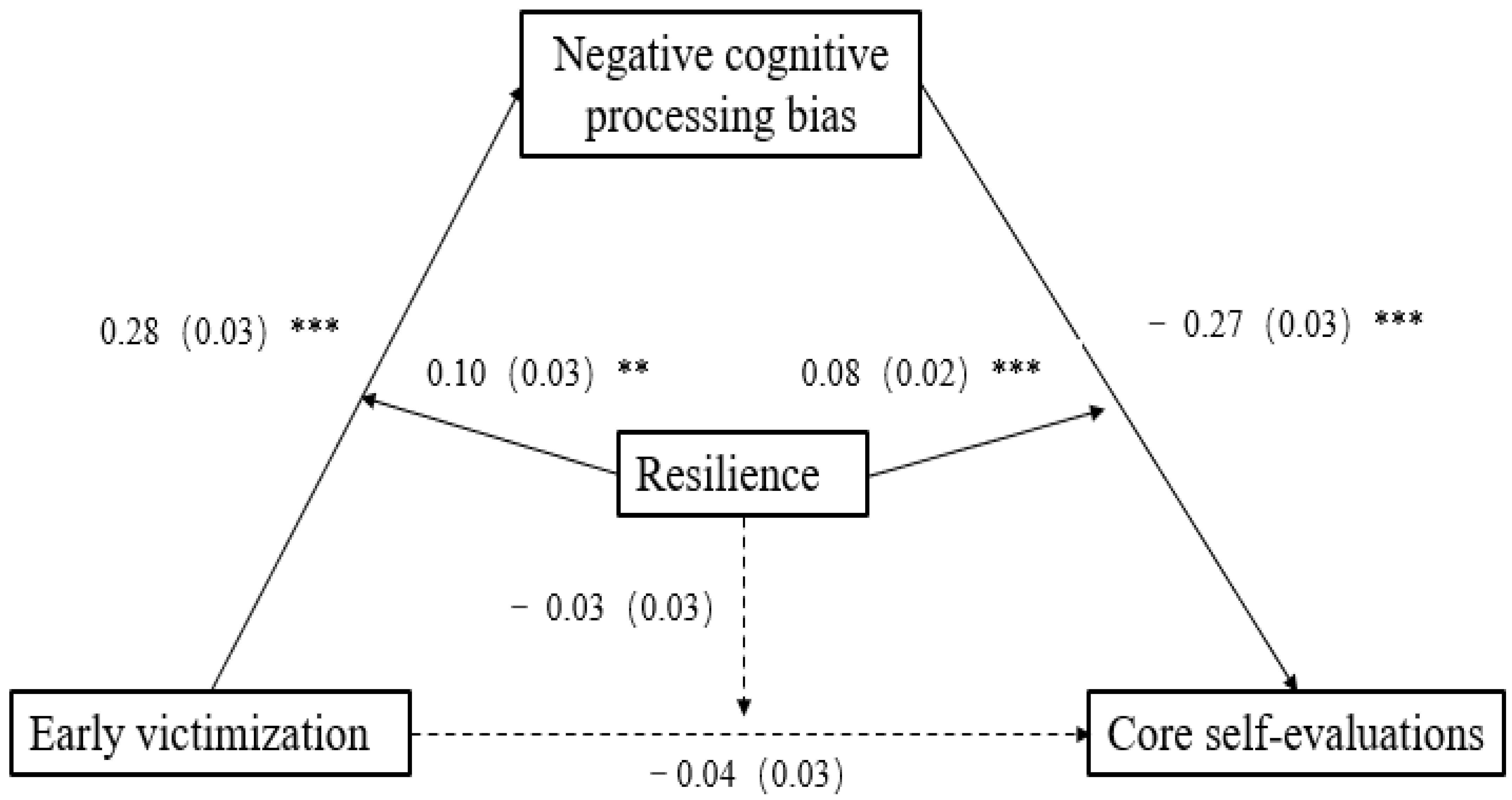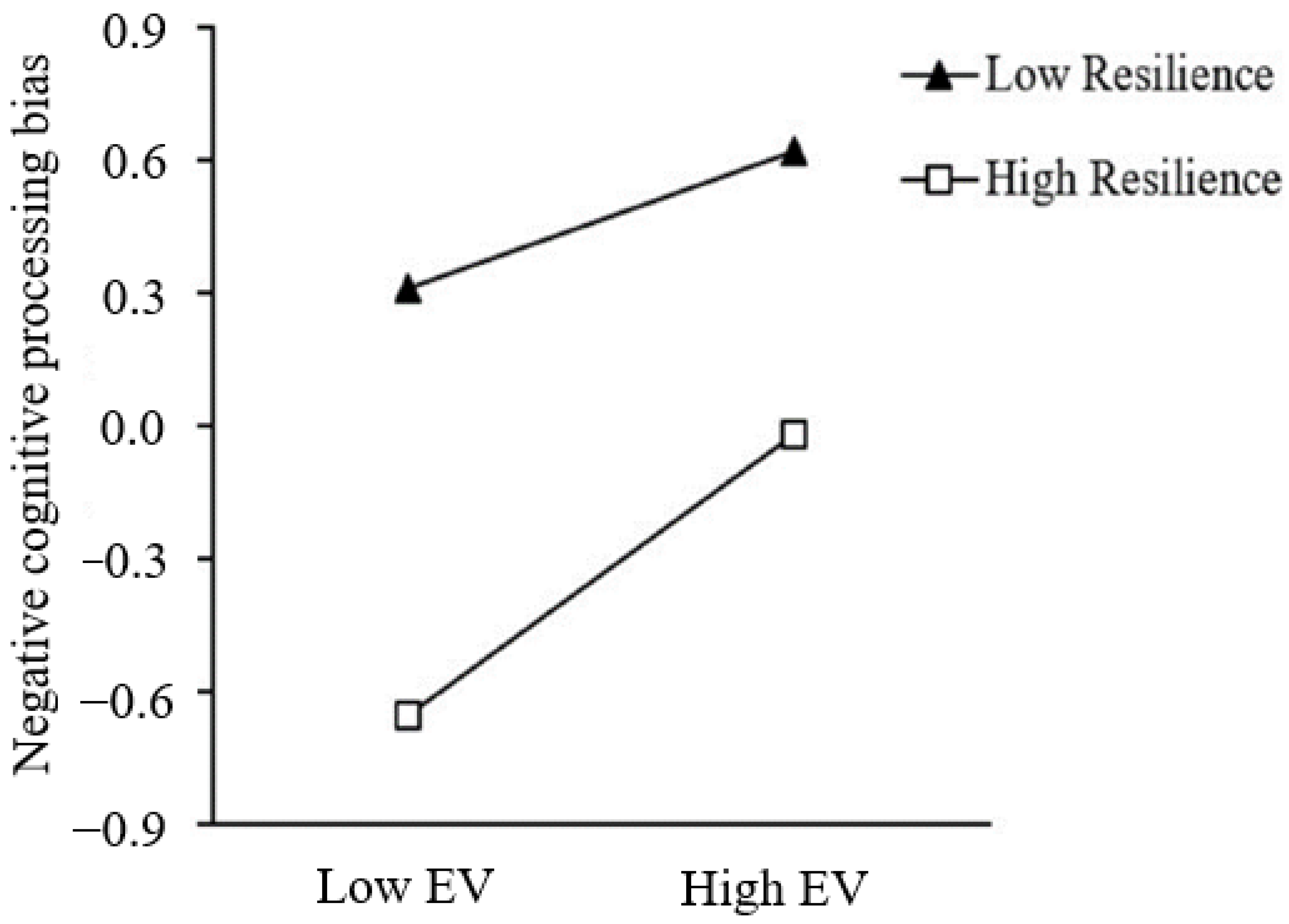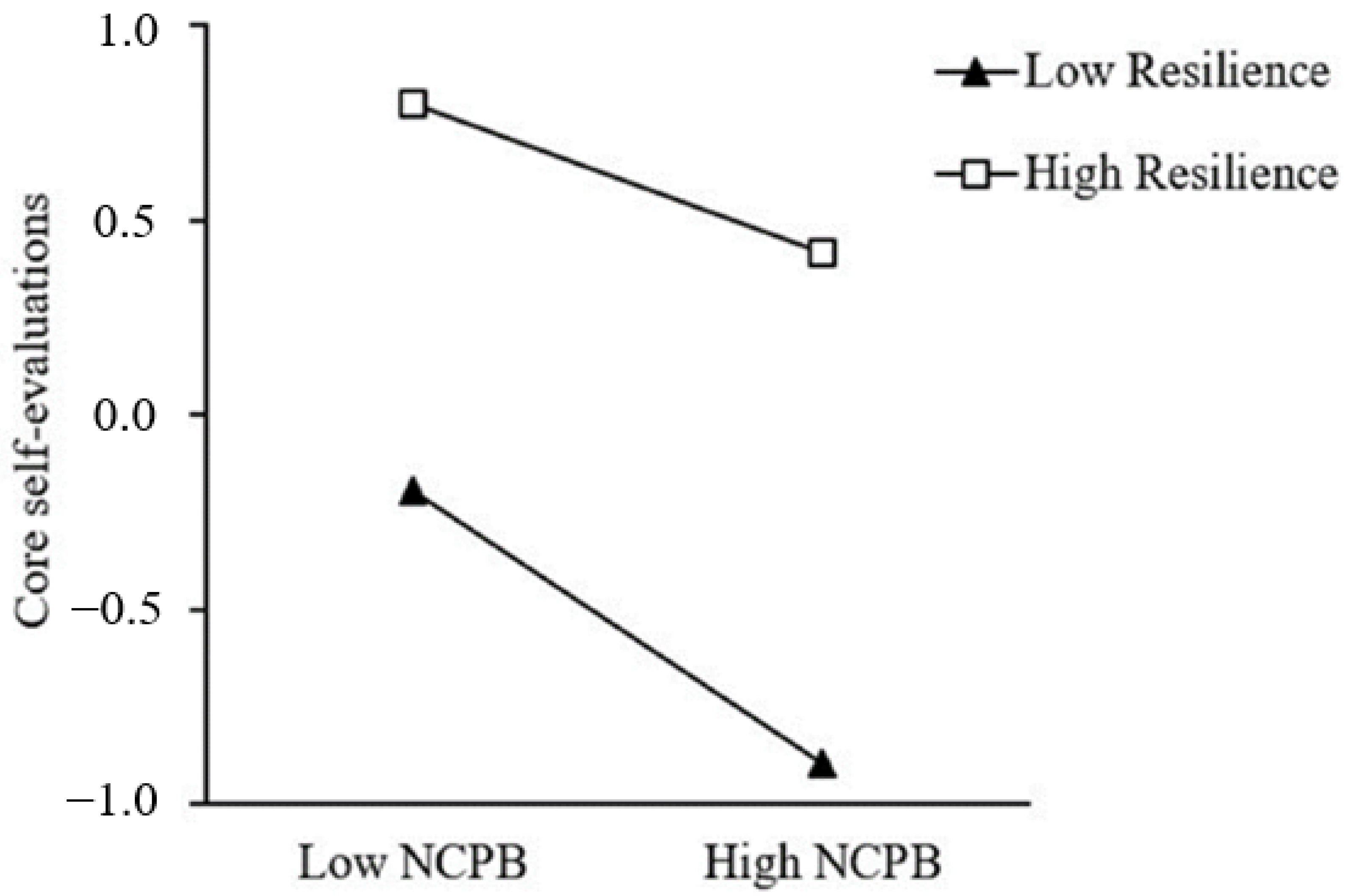Does Early Victimization of School Bullies Affect Core Self-Evaluations in Young Adulthood? A Moderated Mediation Model
Abstract
1. Introduction
1.1. Victimization and Core Self-Evaluations
1.2. The Mediating Role of Negative Cognitive Processing Bias
1.3. The Moderating Role of Resilience
1.4. The Current Study
2. Methods
2.1. Participants and Procedure
2.2. Measures
2.3. Statistical Analysis
3. Results
3.1. Common-Method Bias Test
3.2. Preliminary Analyses
3.3. Testing for the Moderated Mediation Model
4. Discussion
Limitations and Future Directions
5. Conclusions
Author Contributions
Funding
Institutional Review Board Statement
Informed Consent Statement
Data Availability Statement
Acknowledgments
Conflicts of Interest
References
- Judge, T.A.; Locke, E.A.; Durham, C.C. The dispositional causes of job satisfaction: A core evaluations approach. Res. Organ Behave 1997, 19, 151–188. [Google Scholar]
- Judge, T.A.; Bono, J.E. Relationship of core self-evaluations traits—Self-esteem, generalized self-efficacy, locus of control, and emotional stability—With job satisfaction and job performance: A meta-analysis. J. Appl. Psychol. 2001, 86, 80–92. [Google Scholar] [CrossRef] [PubMed]
- Kammeyer-Mueller, J.D.; Judge, T.A.; Scott, B.A. The role of core self-evaluations in the coping process. J. Appl. Psychol. 2009, 94, 177–195. [Google Scholar] [CrossRef] [PubMed]
- Lee, B.; Pfaller, J.; Iwanaga, K.; Chen, X.L.; Wu, J.R.; Chan, F. Core self-evaluations as a mediator of the relationship between stress and quality of life in women with multiple sclerosis. J. Vocat. Rehabil. 2020, 52, 137–144. [Google Scholar] [CrossRef]
- Zhang, Y.; Sun, J.M.J.; Lin, C.H.V.; Ren, H. Linking core self-evaluation to creativity: The roles of knowledge sharing and work meaningfulness. J. Bus. Psychol. 2020, 35, 257–270. [Google Scholar] [CrossRef]
- Erikson, E.H.; Erikson, J.M. The Life Cycle Completed (Extended Version); Norton: New York, NY, USA, 1998. [Google Scholar]
- Tocci, M.C.; Converse, P.D.; Moon, N.A. Core Self-Evaluations Over Time. J. Individ. Differ. 2020, 41, 1–7. [Google Scholar] [CrossRef]
- Ma, L.J.; Li, J.B. The effect of university students’ core self-evaluations and academic burnout on their academic tiresome. Psychol. Dev. Ed. 2009, 25, 101–106. (In Chinese) [Google Scholar]
- Olweus, D. Sweden. In The Nature of School Bullying: A Cross-National Perspective; Smith, P.K., Morita, Y., Junger-Tas, J., Olweus, D., Catalano, R., Slee, P., Eds.; Routledge: London, UK; New York, NY, USA, 1999; pp. 2–27. [Google Scholar]
- Wu, L.; Zhang, D.; Cheng, G.; Hu, T. Bullying and social anxiety in Chinese children: Moderating roles of trait resilience and psychological suzhi. Child Abus. Negl. 2018, 76, 204–215. [Google Scholar] [CrossRef]
- Salmivalli, C.; Lagerspetz, K.M.J.; Björkqvist, K.; Österman, K.; Kaukiainen, A. Bullying as a group proces: Participant roles and their relations to social status within the group. Aggr. Behav. 1996, 22, 1–15. [Google Scholar] [CrossRef]
- Xie, H.; Cui, K.J. Peer victimization, environmental and psychological distress, and academic performance among children in China: A serial mediation model moderated by migrant status. Child Abus. Negl. 2022, 133, 105850. [Google Scholar] [CrossRef]
- McDougall, P.; Vaillancourt, T. Long-term adult outcomes of peer victimization in childhood and adolescence: Pathways to adjustment and maladjustment. Am. Psychol. 2015, 70, 300–310. [Google Scholar] [CrossRef] [PubMed]
- Zhang, W.X.; Gu, C.H.; Ju, Y.C. A Review of Research on the Relationship between Child Bullying and Personality. Adv. Psychol. Sci. 2000, 9, 215–220. [Google Scholar]
- Olweus, D. Annotation: Bullying at school: Basic facts and effects of a school based intervention program. J. Child Psychol. Psychiatry 1994, 35, 1171–1190. [Google Scholar] [CrossRef] [PubMed]
- Blood, G.W.; Blood, I.M. Long-term consequences of childhood bullying in adults who stutter: Social anxiety, fear of negative evaluation, self-esteem, and satisfaction with life. J. Fluency Disord. 2016, 50, 72–84. [Google Scholar] [CrossRef] [PubMed]
- deLara, E.W. Consequences of childhood bullying on mental health and relationships for young adults. J. Child Fam. Stud. 2019, 28, 2379–2389. [Google Scholar] [CrossRef]
- Tsaousis, I. The relationship of self-esteem to bullying perpetration and peer victimization among schoolchildren and adolescents: A mate-analytic review. Aggress Violent Behav. 2016, 31, 186–199. [Google Scholar] [CrossRef]
- Yang, B.L.; Huang, J. Peer bullying and left-behind children’s suicidal ideation: The mediating role of core self-evaluation and the moderating role of intentional self-regulation. Chin. J. Spec. Educ. 2021, 8, 49–57. (In Chinese) [Google Scholar]
- Zhang, S.S.; Zhang, Y.; Shen, T. Study on the influence mechanism of school bullying on middle school students’ core self-evaluation: A gender based multi group comparative analysis. Educ. Sci. Res. 2021, 3, 44–49. (In Chinese) [Google Scholar]
- Rothbard, J.C.; Shaver, P.R. Continuity of attachment across the life span. In Attachment in Adults: Clinical and Developmental Perspectives; Sperling, M.B., Berman, W.H., Eds.; Guilford Press: New York, NY, USA, 1994; pp. 31–71. [Google Scholar]
- Peng, W.; Li, D.; Li, D.; Jia, J.; Wang, Y.; Sun, W. School disconnectedness and Adolescent Internet Addiction: Mediation by self-esteem and moderation by emotional intelligence. Comput. Hum. Behav. 2019, 98, 111–121. [Google Scholar] [CrossRef]
- Chan, H.C.O.; Wong, D.S.W. Traditional school bullying and cyberbullying in Chinese societies: Prevalence and a review of the whole-school intervention approach. Aggress Violent Behav. 2015, 23, 98–108. [Google Scholar] [CrossRef]
- Hymel, S.; Swearer, S.M. Four decades of research on school bullying: An introduction. Am. Psychol. 2015, 70, 293–299. [Google Scholar] [CrossRef] [PubMed]
- Zhang, H.; Han, T.; Ma, S.; Qu, G.; Zhao, T.; Ding, X.; Sun, Y. Association of child maltreatment and bullying victimization among Chinese adolescents: The mediating role of family function, resilience, and anxiety. J. Affect. Disord. 2022, 299, 12–21. [Google Scholar] [CrossRef] [PubMed]
- Arseneault, L. Annual research review: The persistent and pervasive impact of being bullied in childhood and adolescence: Implications for policy and practice. J. Child Psychol. Psychiatry 2017, 59, 405–421. [Google Scholar] [CrossRef] [PubMed]
- Copeland, W.E.; Wolke, D.; Angold, A.; Costello, E.J. Adult Psychiatric Outcomes of Bullying and Being Bullied by Peers in Childhood and Adolescence. JAMA Psychiatry 2013, 70, 419–426. [Google Scholar] [CrossRef] [PubMed]
- Ttofi, M.M.; Farrington, D.P. Bullying: Short-term and long-term effects, and the importance of defiance theory in explanation and prevention. Vict. Offenders 2008, 3, 289–312. [Google Scholar] [CrossRef]
- Ttofi, M.M.; Farrington, D.P.; Lösel, F.; Loeber, R. Do the victims of school bullies tend to become depressed later in life? A systematic review and meta-analysis of longitudinal studies. J. Aggress. Confl. Peace Res. 2011, 3, 63–73. [Google Scholar] [CrossRef]
- Lerner, R.M.; Lerner, J.V.; Almerigi, J.; Theokas, C.; Phelps, E.; Naudeau, S.; Von Eye, A. Towards a new vision and vocabulary about adolescence: Theoretical, empirical, and applied bases of a “Positive Youth Development” perspective. In Child Psychology: A Handbook of Contemporary Issues; Balter, L., Tamis-LeMonda, C.S., Eds.; Psychology Press: New York, NY, USA, 2006; pp. 445–469. [Google Scholar]
- Yan, X.F.; Zhang, R.; Feng, Z.Z. Development of negative cognitive processing bias questionnaire. J. Third Mil. Med. Univ. 2017, 39, 2329–2334. [Google Scholar] [CrossRef]
- Beck, A.T. The evolution of the cognitive model of depression and its neurobiological correlates. Am. J. Psychiatry 2008, 165, 969–977. [Google Scholar] [CrossRef] [PubMed]
- Cole, D.A.; Maxwell, M.A.; Dukewich, T.L. Targeted peer victimization and the construction of positive and negative self-cognitions: Connections to depressive symptoms in children. J. Clin. Child Adolesc. Psychol. 2010, 39, 421–435. [Google Scholar] [CrossRef] [PubMed]
- Cole, D.A.; Rachel, L.; Zelkowitz1, R.L.; Nick, E.; Nina, C.; Martin, N.C.; Kathryn, M.; Roeder, K.M.; Sinclair-McBride, K.; Spinelli, T. Longitudinal and incremental relation of cybervictimization to negative self-cognitions and depressive symptoms in young adolescents. J. Abnorm. Child Psychol. 2016, 44, 1321–1332. [Google Scholar] [CrossRef]
- Paredes, P.P.; Calvete, E. Cognitive vulnerabilities as mediators between emotional abuse and depressive symptoms. J. Abnorm. Child Psychol. 2014, 42, 743–753. [Google Scholar] [CrossRef] [PubMed]
- McCabe, R.E.; Miller, J.L.; Laugesen, N.; Antony, M.M.; Young, L. The relationship between anxiety disorders in adults and recalled childhood teasing. J. Anxiety Disord. 2010, 24, 238–243. [Google Scholar] [CrossRef] [PubMed]
- Robinson, O.J.; Overstreet, C.; Allen, P.S.; Letkiewicz, A.; Vytal, K.; Pine, D.S.; Grillon, C. The role of serotonin in the neurocircuitry of negative affective bias: Serotonergic modulation of the dorsal medial prefrontal-amygdala ‘aversive amplification’ circuit. Neuroimage 2013, 78, 217–223. [Google Scholar] [CrossRef]
- Weiner, B. An Attributional Theory of Motivation and Emotion; Springer: New York, NY, USA, 1986; p. 10. [Google Scholar] [CrossRef]
- Cole, D.A.; Dukewich, T.L.; Roeder, K.; Sinclair, K.R.; McMillan, J.; Will, E.; Felton, J.W. Linking peer victimization to the development of depressive self-schemas in children and adolescents. J. Abnorm. Child Psychol. 2014, 42, 149–160. [Google Scholar] [CrossRef]
- Saroyan, J. Bullying affects the core self of children. Peace Rev. 2019, 31, 24–33. [Google Scholar] [CrossRef]
- Smith, P.K.; Talamelli, L.; Cowie, H.; Naylor, P.; Chauhan, P. Profiles of non-victims, escaped victims, continuing victims and new victims of school bullying. Br. J. Educ. Psychol. 2004, 74, 565–581. [Google Scholar] [CrossRef]
- Rutter, M. Resilience as a dynamic concept. Dev. Psychopathol. 2012, 24, 335–344. [Google Scholar] [CrossRef]
- Rutter, M. Psychosocial resilience and protective mechanisms. Am. J. Orthopsychiat. 1987, 57, 316–331. [Google Scholar] [CrossRef]
- Hu, T.; Zhang, D.; Wang, J. A meta-analysis of the trait resilience and mental health. Personal. Individ. Differ. 2015, 76, 8–27. [Google Scholar] [CrossRef]
- Masten, A.S.; Barnes, A.J. Resilience in children: Developmental perspectives. Children 2018, 5, 98. [Google Scholar] [CrossRef]
- Aliyev, R.; Gengec, H. The effects of resilience and cyberbullying on self-esteem. J. Educ. 2019, 199, 155–165. [Google Scholar] [CrossRef]
- Moore, B.; Woodcock, S. Resilience, bullying, and mental health: Factors associated with improved outcomes. Psychol. Sch. 2017, 54, 689–702. [Google Scholar] [CrossRef]
- Narayanan, A. Bullying behaviors and victimization experiences among adolescent students: The role of resilience. J Genet Psychol 2014, 175, 134–146. [Google Scholar] [CrossRef]
- Annor, F.; Amponsah-Tawiah, K. Relationship between workplace bullying and employees’ subjective well-Being: Does resilience make a difference? Employ Responsib. Rig. 2020, 32, 123–135. [Google Scholar] [CrossRef]
- Villora, B.; Larrañaga, E.; Yubero, S.; Alfaro, A.; Navarro, R. Relations among poly-victimization, subjective well-being and resilience in a sample of late adolescents. Int. J. Environ. Res. Public Health 2020, 17, 590. [Google Scholar] [CrossRef] [PubMed]
- Hornor, G. Resilience. J. Pediatr. Health Care 2017, 31, 384–390. [Google Scholar] [CrossRef] [PubMed]
- Tugade, M.M.; Fredrickson, B.L. Resilient individuals use positive emotions to bounce back from negative emotional experience. J. Pers. Soc. Psychol. 2004, 86, 320. [Google Scholar] [CrossRef]
- Hinduja, S.; Patchin, J.W. Cultivating youth resilience to prevent bullying and cybervictimization. Child Abuse Neglect 2017, 73, 51–62. [Google Scholar] [CrossRef]
- Zhang, W.X.; Wu, J.F.; Jones, K. Revised version of the Olweus Bully/Victim Questionnaire. Psychol. Dev. Educ. 1999, 2, 7–8. (In Chinese) [Google Scholar] [CrossRef]
- Liang, B.Y.; Cheng, C. Psychological health diathesis assessment system: The development of resilient trait scale for Chinese adults. Stud. Psychol. Behav. 2012, 10, 269–277. (In Chinese) [Google Scholar]
- Du, J.Z.; Zhang, X.; Zhao, Y. Reliability, validation and construct confirmatory of core self-evaluations scale. Psychol. Res. 2012, 5, 54–60. (In Chinese) [Google Scholar]
- Judge, T.A.; Erez, A.; Bono, J.E.; Thoresen, C.J. The core self-evaluations scale: Development of a measure. Pers. Psychol. 2003, 56, 303–331. [Google Scholar] [CrossRef]
- Podsakoff, P.M.; Organ, D.W. Self-report in organizational research: Problems and prospects. J. Manag. 1986, 12, 531–544. [Google Scholar] [CrossRef]
- Zhang, W.X. Bullying in primary and middle schools: Some basic facts that we know. J. Shandong Norml. Univ. (Soc. Sci.) 2001, 1, 3–7. (In Chinese) [Google Scholar] [CrossRef]
- Hayes, A.F. Introduction to Mediation, Moderation, and Conditional Process Analysis: A Regression-Based Approach, 2nd ed.; Guilford Press: New York, NY, USA, 2018; pp. 6–7. [Google Scholar]
- Zhou, H.; Long, L.R. Statistical remedies for common method biases. Adv. Psych. Sci. 2004, 12, 942–950. (In Chinese) [Google Scholar]
- Podsakoff, P.M.; Mackenzie, S.B.; Lee, J.Y.; Podsakoff, N.P. Common method biases in behavioral research: A critical review of the literature and recommended remedies. J. Appl. Psychol. 2003, 88, 879–903. [Google Scholar] [CrossRef] [PubMed]
- Fisher, B.J.; Gardella, J.H.; Teurbe-Tolon, A.R. Peer cybervictimization among adolescents and the associated internalizing and externalizing problems: A meta-analysis. J. Youth Adolesc. 2016, 45, 1727–1743. [Google Scholar] [CrossRef] [PubMed]
- Brown, L.A.; Belli, G.M.; Asnaani, A.; Foa, E.B. A review of the role of negative cognitions about oneself, others, and the world in the treatment of PTSD. Cogn. Ther. Res. 2019, 43, 143–173. [Google Scholar] [CrossRef]
- Young-Jones, A.; Fursa, S.; Byrket, J.S.; Sly, J.S. Bullying affects more than feelings: The long-term implications of victimization on academic motivation in higher education. Soc. Psychol. Educ. 2015, 18, 185–200. [Google Scholar] [CrossRef]
- van den Eijnden, R.; Vermulst, A.; van Rooij, A.J.; Scholte, R.; van de Mheen, D. The bidirectional relationships between online victimization and psychosocial problems in adolescents: A comparison with real-life victimization. J. Youth Adolesc. 2014, 43, 790–802. [Google Scholar] [CrossRef]
- Özer, A.; Totan, T.; Atik, G. Individual Correlates of bullying behavior in Turkish Middle Schools. Aust. J. Guid. Couns. 2011, 21, 186–202. [Google Scholar] [CrossRef]
- Wang, X.Q.; Zhang, Y.; Hui, Z.Z.; Bai, W.Y.; Terry, P.D.; Ma, M.; Li, Y.; Cheng, L.; Gu, W.; Wang, M.X. The mediating effect of regulatory emotional self-efficacy on the association between self-esteem and school bullying in middle school students: A cross-sectional study. Int. J. Environ. Res. Public Health 2018, 15, 991. [Google Scholar] [CrossRef]
- Li, D.P. Multiple ecological risk factors and adolescents’ social adaptation: How risks should be modeled and what are their mechanisms. Doctoral dissertation, South China Normal University, Guangzhou, China, 2012. [Google Scholar]
- Mahdiani, H.; Ungar, M. The dark side of resilience. Advers. Resil. Sci. 2021, 2, 147–155. [Google Scholar] [CrossRef]
- Wu, N.N.; Hou, Y.; Zeng, Q.; Cai, H.T.; You, J.N. Bullying Experiences and Nonsuicidal Self-injury among Chinese Adolescents: A Longitudinal Moderated Mediation Model. J. Youth Adolesc. 2021, 50, 753–766. [Google Scholar] [CrossRef]
- Wolke, D.; Lereya, S.T. Long-term effects of bullying. Arch. Dis. Child 2015, 100, 879–885. [Google Scholar] [CrossRef]
- Bowes, L.; Maughan, B.; Caspi, A.; Moffitt, T.E.; Arseneault, L. Families promote emotional and behavioral resilience to bullying: Evidence of an environmental effect. J. Child Psychol. Psychiatry 2010, 51, 809–817. [Google Scholar] [CrossRef]
- Choi, B.; Park, S. Bullying perpetration, victimization, and low self-esteem: Examining their relationship over time. J. Youth Adolesc. 2021, 50, 739–752. [Google Scholar] [CrossRef]
- Kowalski, R.M.; Giumetti, G.W.; Schroeder, A.N.; Lattanner, M.R. Bullying in the Digital Age: A Critical Review and Meta-Analysis of Cyberbullying Research Among Youth. Psychol. Bull. 2014, 140, 1073–1137. [Google Scholar] [CrossRef]




| M | SD | 1 | 2 | 3 | 4 | |
|---|---|---|---|---|---|---|
| 1 EBV | 1.29 | 0.41 | 1 | |||
| 2 NCPB | 2.21 | 0.48 | 0.30 ** | 1 | ||
| 3 Resilience | 2.82 | 0.38 | −0.27 ** | −0.48 ** | 1 | |
| 4 CSE | 3.51 | 0.64 | −0.21 ** | −0.56 ** | 0.69 ** | 1 |
| Model | Predictors | β | SE | t | 95%CI |
|---|---|---|---|---|---|
| Model 1 (NCPB) | Gender | 0.28 | 0.06 | 4.77 *** | [0.17, 0.40] |
| EV | 0.28 | 0.03 | 8.30 *** | [0.21, 0.35] | |
| Resilience | −0.42 | 0.03 | −14.23 *** | [−0.48, −0.36] | |
| EV × Resilience | 0.10 | 0.03 | 2.93 ** | [0.03, 0.16] | |
| R2 | 0.29 | ||||
| F | 91.83 *** | ||||
| Model 2 (CSE) | Gender | −0.22 | 0.05 | −4.55 *** | [−0.31, −0.13] |
| EV | −0.04 | 0.03 | −1.33 | [−0.09, 0.02] | |
| Resilience | 0.58 | 0.03 | 21.75 *** | [0.53, 0.64] | |
| EV × Resilience | −0.03 | 0.03 | −0.91 | [−0.08, 0.03] | |
| NCPB | −0.27 | 0.03 | −10.10 *** | [−0.32, −0.22] | |
| NCPB × Resilience | 0.08 | 0.02 | 3.92 *** | [0.04, 0.12] | |
| R2 | 0.56 | ||||
| F | 184.79 *** | ||||
| Conditional direct effect analysis at Resilience = M ± SD | β | Boot SE | BootLLCI | BootULCI | |
| M − 1 SD (2.44) | −0.01 | 0.03 | −0.07 | 0.05 | |
| M (2.82) | −0.04 | 0.03 | −0.09 | 0.02 | |
| M + 1 SD (3.20) | −0.06 | 0.05 | −0.16 | 0.03 | |
| Conditional indirect effect analysis at Resilience = M ± SD | β | Boot SE | BootLLCI | BootULCI | |
| M − 1 SD (2.44) | −0.06 | 0.02 | −0.10 | −0.03 | |
| M (2.82) | −0.08 | 0.01 | −0.10 | −0.05 | |
| M + 1 SD (3.20) | −0.07 | 0.02 | −0.11 | −0.04 | |
Disclaimer/Publisher’s Note: The statements, opinions and data contained in all publications are solely those of the individual author(s) and contributor(s) and not of MDPI and/or the editor(s). MDPI and/or the editor(s) disclaim responsibility for any injury to people or property resulting from any ideas, methods, instructions or products referred to in the content. |
© 2023 by the authors. Licensee MDPI, Basel, Switzerland. This article is an open access article distributed under the terms and conditions of the Creative Commons Attribution (CC BY) license (https://creativecommons.org/licenses/by/4.0/).
Share and Cite
Wang, L.; Zhou, S.; Xue, Y.; Li, Q.; Cao, M.; Gu, C. Does Early Victimization of School Bullies Affect Core Self-Evaluations in Young Adulthood? A Moderated Mediation Model. Int. J. Environ. Res. Public Health 2023, 20, 3338. https://doi.org/10.3390/ijerph20043338
Wang L, Zhou S, Xue Y, Li Q, Cao M, Gu C. Does Early Victimization of School Bullies Affect Core Self-Evaluations in Young Adulthood? A Moderated Mediation Model. International Journal of Environmental Research and Public Health. 2023; 20(4):3338. https://doi.org/10.3390/ijerph20043338
Chicago/Turabian StyleWang, Lixia, Shuzhi Zhou, Yukang Xue, Qianqian Li, Min Cao, and Chuanhua Gu. 2023. "Does Early Victimization of School Bullies Affect Core Self-Evaluations in Young Adulthood? A Moderated Mediation Model" International Journal of Environmental Research and Public Health 20, no. 4: 3338. https://doi.org/10.3390/ijerph20043338
APA StyleWang, L., Zhou, S., Xue, Y., Li, Q., Cao, M., & Gu, C. (2023). Does Early Victimization of School Bullies Affect Core Self-Evaluations in Young Adulthood? A Moderated Mediation Model. International Journal of Environmental Research and Public Health, 20(4), 3338. https://doi.org/10.3390/ijerph20043338





